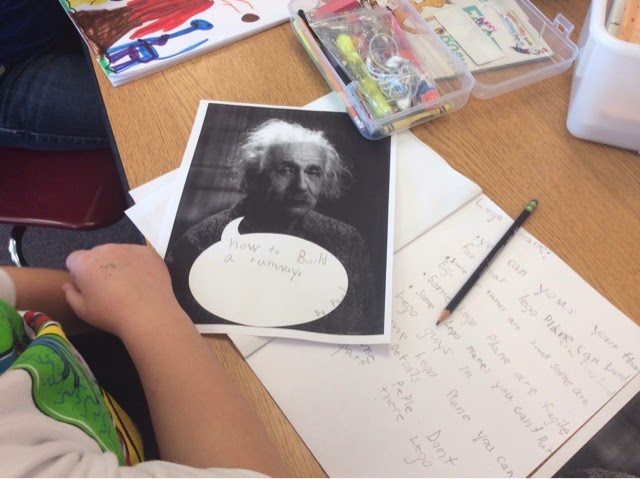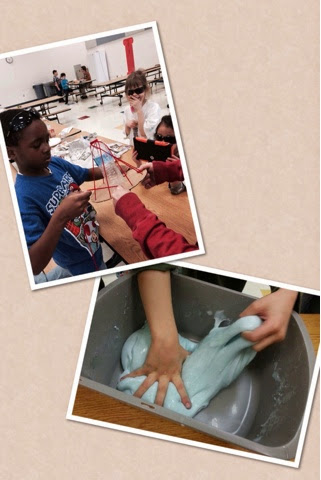Technology involved: 12 ipads and 3 computers
Genius Hour is 1st Grade!
Yes, it can be done.
It can go smoothly.
It WILL be their favorite part of the year!
Here is a guide to our journey in Room 222:
 |
| Inspired by @mwhitedg |
Hour 1: Wall of Wonder
How it looked: I introduced the idea of Genius Hour by showing this video:
We talked about how Genius Hour is really something that the students are in charge of. This really got them excited. To begin our process, we gathered post-its and just started writing everything they were wondering about. We posted these on our Wall of Wonder.
Hour 2: Get an Idea!
During this hour, we reviewed our Wall of Wonder and each student chose one post-it off of their page to be their 1st Genius Hour wonder. Once their chose their topic and we had a quick conference to inform me of what it was, they students decorated their journal covers.
Hour 3: Draw About It
Creation is a major part of learning in 1st grade. Many times, their powerful thoughts come from their sketches and drawings more than from their written words. During this hour, they drew sketches and illustrations of their topics. Many students chose to include labels and information that they knew.
Hour 4: Write all you Know (Schema)
This was done in a list format. Each student made a list of everything they already knew about their topic. Then we discussed the idea of a driving question. This was very tricky for some of them to get. We discussed the difference between a Genius question and a Google question.
A Google question is one that can be answered with a quick Google search. A Genius question is deep and needs the work of a 1st grade genius to tackle it.
Here were some of our questions:
How can I best take care of my cat/dog?
How can a build the best Lego runway?
How do volcanoes explode?
What is a day in the life of a Police Officer like?
Reflection: The question was really hard for many of them. I am rethinking this phase.
Hour 5: Search
This hour took us to the library where we searched for books on their topics and searched the internet for articles or blog posts. The internet makes me very nervous in 1st grade but that doesn't cause me to shy away from it. We spend a lot of time in our room talking about digital citizenship, digital safety, proper internet searching and the quality of websites.
We use Kidrex.org as our go-to search engine. It is filtered and very appropriate but the essential digital conversations are necessary. Plan to have a few adults to help you with this phase. They are also handy when keeping an eye on the internet searches. There were 4 adults total to help my students with this phase.
Hour 6: Take Notes
It was time to put our sources to use. During this hour, they students spend time reading their books and articles. Many students also found videos to watch on their topics. This gave me a little teacher-anxiety because I had not previewed the videos they were watching so we created a plan. If the video was from a site that we use often like National Geographic Kids, PebbleGo or Brainpop, then they could just go and watch it. If it was from a site other than these, they had to let me preview it first.
I had to approve many of them and this trapped me in a corner for a bit but it was worth it because my kids gained so much more information than they would have gotten from the the text they had checked out.
A few of the videos I had to watch all of the way through but must I was able to just glance at and approve.
The students took notes using a graphic organizer that was tricky and I won't use again. We use something different next time with more levels of modeling involved.
Reflection: This area needs to be improved. I plan on doing this with a year long set-up of research and inquiry.
Behind the Scenes:
At this point, I contacted several trusted parents to help be assistants in the creation phase. They would be buddied with 3-4 students/projects.
Hour 7: Plan
It was time to put all of our knew knowledge into action. The students set out to create a plan of action about what they were going to create and how they were going to share their new learning with their peers.
They had to answer the following questions:
What is my Genius Question?
What is my plan to create and share?
What materials do I need?
The students filled this out with some assistance from me. To be honest, I was a bit worried after this phase. While reading through their plans, I was worried that they didn't really get it. I wasn't seeing a clear picture of what most of them were doing. So I made a Plan B.
Hour 8: Plan again...
Plan B - Silly me. I am a huge advocate of information through voice and video and yet I asked my 6-7 year olds to write a proposal! I took a step back and wondered how I could really get inside their heads. Answer... video!
I assigned each student to a parent group and had the groups make videos for their parent helpers. They briefly explained their plans to their helpers.
Here is an example of one of their videos:
These videos were then sent (with a password via Vimeo) to the parent helpers to help get them ready for what was in store for them. Many of our other videos contained names with faces so they won't be posted on this blog. Please contact me if you would like to see the other videos in order to plan your Genius Hour process.
Hour 9 and 10: Create!
This phase scared me the most. I am not the most organized person and I really needed to be organized here. So I started contacting and planning several weeks in advance for this phase. Here are the specifics:
- 8 Adults: 1 Teacher, 1 student teacher, 1 para and 5 parents
- 3-4 kids to a group
- Each group split up into two mini groups. Week 1: Project Managers initiated their projects with the assistance of their helpers. 12 projects were completed in week one. The second week, jobs switched and the other 12 projects were completed. See diagram:

- I paired calmer projects with more active projects. For example, my student studying sharks and making a shark out of Model Magic (calmer project) was paired with a student that was cooking a dessert and making a punch (active project). This allowed for students with calmer projects to assist with the more active ones.
- Room 222 parents were sent a materials list prior to the event and all materials were donated and ready to go.
- Recipes were shared with all families to check for allergies and give parents a chance to choose if they would like their child to have a small sampling of the culinary creation.
- We rented our lunch room (with kitchen) to assure we had room for all of our projects.
- A supply table was set up so the student could grab what they needed.
- Adults and students received directions at the same time to eliminate confusion.
Finally, we just jumped in with both feet and began creating! It was amazing! Everything ran so smoothly. Everyone participated as needed. Some students stepped up and shined in a way that they wouldn't have been able to do otherwise.
Once everything was done and we all calmed down, they started to post their projects (published in iMovie) to their blogs.
Here are a few examples:
My final reflections: I am not totally sure that a guiding question is needed in 1st grade. Many of them just what to know everything they can. It was difficult to narrow it down.
I was worried about the students not being able to keep their focus for 6-10 weeks but this was not a problem. I strongly recommend a visual like mine to help them see the path. This answered a lot of questions. Feel free to use my visual.
The research phase is what I need to improve on the most. I plan on starting the next year with Inquiry Circles to help given them a more solid base to work with when they move on to their independent projects.
My guide: Click for more info
Lastly, this was an amazing experience and I am so glad we did it.
The kids are already asking for the next round.
I can't wait to try it again. I am so proud of the learning that my students presented.
I hope this was helpful. Please feel free to contact me with any questions.
Laura.Bright@kaneland.org










Thanks tons for sharing! I do many components of genius hour in my classroom but i would not say that I do genuis hour. It was great to read how you made it work for your students. It gives me something to think about. Karen Lirenman
ReplyDeleteThanks for this inspiring post! It's very helpful for those of us trying to picture how student driven inquiry can work in the primary grades. Shereen Zaky
ReplyDeleteThis comment has been removed by a blog administrator.
ReplyDeleteThanks for the step-by-step directions! Love it!
ReplyDeleteThank you, my first grader is just starting this in his classroom and I wasn't sure how this would work. I'm happy to hear about your experience and that I'll be amazed to see what he and his classmates come up with. I'm hoping I get to help as a parent, but want to support in any way possible, without giving him the answers.
ReplyDeleteRight now, the staff at my school is looking at your blog and reading parts out loud as we brainstorm ideas for genius hour at our school. Thank you for sharing!
ReplyDeleteI've been so hesitant to start with my fifth graders, but now I am encouraged! Thank you so much for sharing your experience!
ReplyDeleteThank you for thoroughly outlining your project. I teach 6th grade and am jumping in with both feet. Your blog post was a great resource.
ReplyDeleteThis comment has been removed by the author.
ReplyDeleteThank you so much for sharing! I am really excited to try this with my first graders.
ReplyDeletenice post thanks for sharing this post with us
ReplyDeleteMy friend does Genius Hour with her third graders. I teach first grade and want to give it a go. Thanks for posting your process with your little ones!!
ReplyDelete